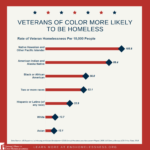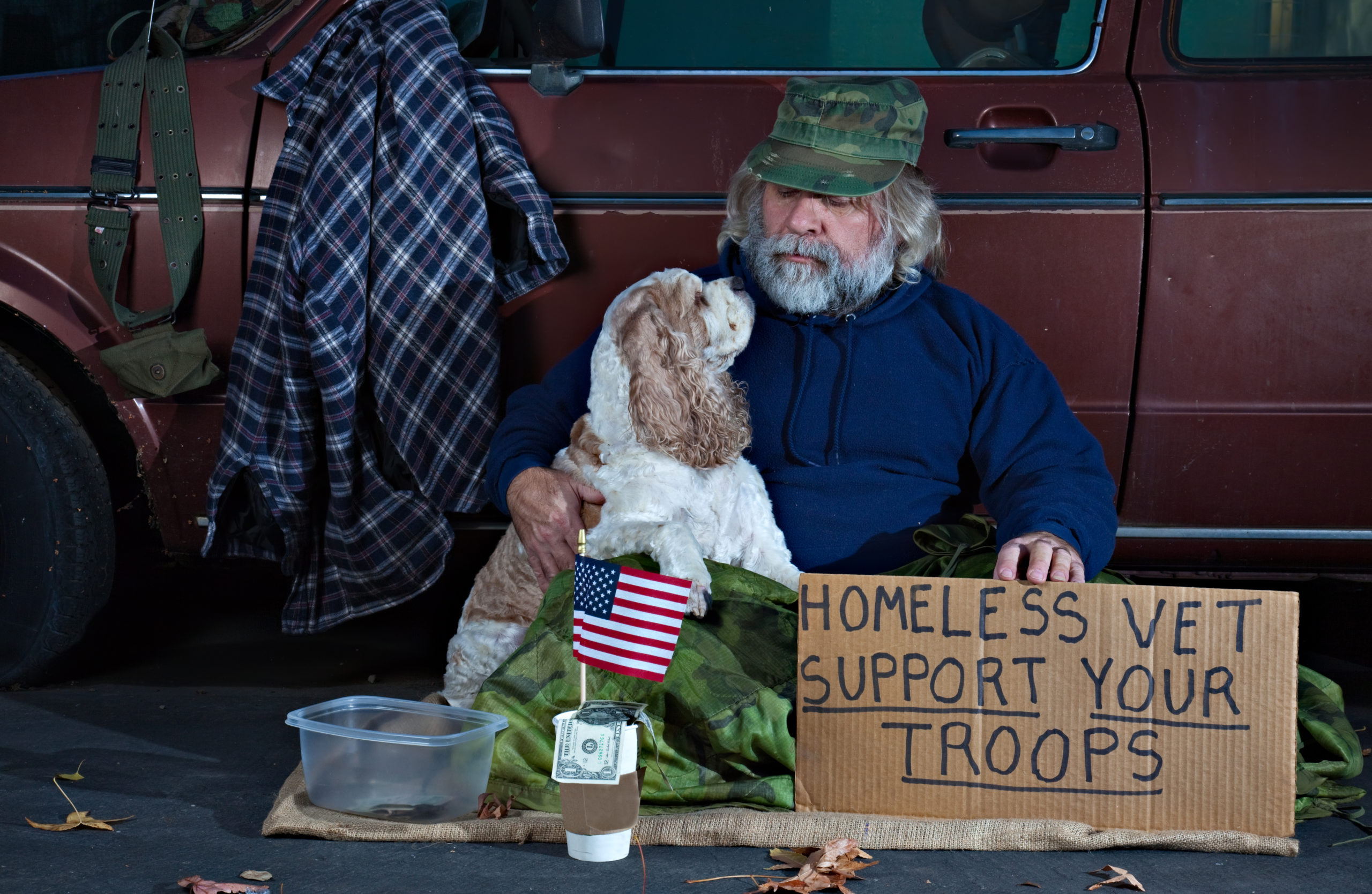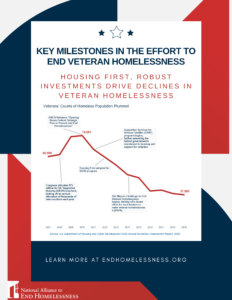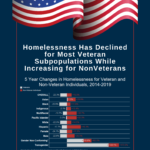In November, the nation takes a day off to honor its veterans. In recent years, the homeless services world has held these sentiments all year long: diligently working to secure permanent housing for everyone who has served our country.
Below are five key facts about these efforts, and the remaining barriers on the road to finally ending veterans’ homelessness in America.
#1 Dramatic Drops in Veteran Homelessness are Associated with Housing First and Increased Government Investments
Within a decade (2010-2019), America’s number of homeless veterans was roughly cut in half. The reduction from 74,087 to 37,085 veterans experiencing homelessness far exceeded the progress realized by chronically homeless individuals and all other subpopulations.
During this period, various actors joined a fight to end veterans’ homelessness. They included the Obama Administration; members of Congress from both sides of the aisle; and a broad, bipartisan group of mayors, governors, and county officials from across the country.
Two ingredients are associated with their success: 1) Housing First and 2) investments in veteran-specific programs.
The HUD-VASH program adopted Housing First strategies in 2012. The approach, an internationally recognized best practice, has proven effective for veterans—reducing housing placement waiting times from 223 to 35 days, improving retention in permanent housing, and reducing emergency room trips. Supportive Services for Veterans Families (SSVF), which began in 2011, complements these efforts. It offers rapid re-housing (which stabilizes over 70 percent of participants in permanent housing) and prevention services.
Housing First through HUD-VASH and SSVF were not only implemented, but Congress also funded them consistently to the needed scale. As a result, they are able to successfully house thousands of veterans.
#2 Being a Veteran Increases the Risk of Becoming Homeless – But That’s Changing
Historically, national policy failures have meant that veterans are more likely to experience homelessness. In 2019, 21 out of every 10,000 veterans were homeless. This number is only slightly higher than the overall homeless rate of 17 out of every 10,000 Americans. Increased focus on promoting Housing First, as well as increased federal funding for veteran homelessness, have helped to narrow the gap.
#3 Veterans of Color are More Likely to Experience Homelessness
 Veterans of color have the highest likelihood of being homeless. Native Hawaiian and Pacific Islander veterans are most at-risk—106 out every 10,000 are homeless, despite their service to our country. American Indians and Black people have similarly elevated numbers.
Veterans of color have the highest likelihood of being homeless. Native Hawaiian and Pacific Islander veterans are most at-risk—106 out every 10,000 are homeless, despite their service to our country. American Indians and Black people have similarly elevated numbers.
Significantly, all racial and ethnic subgroups have benefited from the movement to end veterans’ homelessness. For Black veterans, who experienced the most significant drop in homelessness (26 percent) over the last five years, the movement helps reduce disparities between them and other groups.
#4 COVID-19 and the Recession May Be a Setback
Within the homeless services world, COVID-19-related unemployment rates and evictions are a cause for alarm. Streams of new clients may be coming to seek assistance from providers.
Most job losses will not result in literal homelessness, but it is a risk factor. Unfortunately, sheltered veterans disproportionately fall into two categories facing barriers in the pandemic-impacted job market: older adults and people with disabilities. Within the former category, researchers are flagging that people 55 and over have been losing jobs faster and returning to work slower than middle-aged workers. And advocates worry that people with disabilities are more likely to be in retail jobs being lost in the recession. These challenges may drive more veterans into homelessness while making it harder for them to get out.
Despite the existence of government moratoriums, evictions are still occurring throughout the United States. Worse, the current national moratorium will expire on December 31, and it’s unclear whether renters will receive further aid. Impacted people are at-risk of homelessness. And advocates have been reporting troubling stories of veterans facing recent evictions.
#5 We Can End Homelessness for Veterans. We Can End Homelessness for Everyone.
In the years leading up to the pandemic, veteran homelessness was cut roughly in half, and the US Interagency Council on Homelessness has recognized 79 communities and 3 states as ending it (ensuring that it is rare, brief, and one-time).
Since Housing First and government investments have helped to produce such results, the combination can likely help any veterans driven into homelessness by COVID-19 – and all other people experiencing homelessness.



